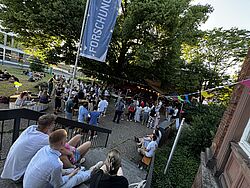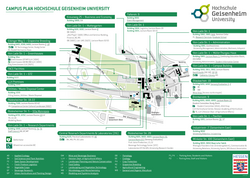Entitled "Above and Below – Towards the Future", the conference will address the key challenges in viticulture, both in the present and in the future. In particular the program focuses on physiological responses to abiotic and biotic stresses, sustainable and organic viticulture, and soil and water management.
Explore our comprehensive program below!
Downloads
Monday 28.07.25
| Registration still open | ||
| 8:30 am | Opening session | |
| Prof. Laurent Torregrosa | GiESCO organisation | |
| Dr. Barker | OIV | |
| IVES | International Viticulture and Enology Society (IVES) for enabling a special issue of seven articles through OENO One, and for publishing the proceedings on the IVES Conference Series platform, thereby securing long-term visibility of your work | |
| Prof. Dr. Hans Reiner Schultz | President of the Geisenheim university | |
| Prof. Dr. Manfred Stoll | Head of Department of general and organic viticulture | |
| Rudolf Hermans foundation keynote speaker | Kees van Leeuwen | Above and below – research challenges for the future of winegrape production |
| Session 1 | Soil and water management | |
| 09:30 - 09:55 | Javaux, Mathieu | The key role of soil texture on vine water status under water-limited conditions |
| 09:55 - 10:02 | Fernandez Garcia, Rafaèle held by Saint - Cast, Clement | Field heterogeneity of soil properties influences root architecture and anatomical development in vineyards |
| 10:02 - 10:15 | Damásio, Miguel | Root Water Uptake patterns in Rootstock-Scion Interactions Influence grape water use strategies in a Mediterranean Vineyard |
| 10:15 - 10:45 | COFFEE BREAK | |
| 10:45 - 10:58 | Diverres, Geraldine | Above and below: Soil moisture and soil temperature interact to alter grapevine water relations |
| 10:58 - 11:11 | Hofmann, Marco | Water balance modeling for climate change adaptation and knowledge transfer |
| 11:11 - 11:24 | Smith, Jason | Factors influencing cover crop water competition in vineyards and implications for future drought adaptation: |
| 11:24 - 11:37 | Weihbrecht, Katharina | Under - vine cover crops in viticulture: Impact of different weed management practices on weed suppression, yield and quality of grapevine cultivar Riesling |
| 11:37 - 11:44 | de Gracia, M. Isabel held by Santesteban, Gonzaga | Water dynamics in vineyard soils and vines, and their responses to under - vine cover crops |
| 11:44 - 11:57 | Wong, Connie T. F. | Linking soil C cycling and microbial diversity under regenerative management in Northern California (USA) vineyards |
| 11:57 - 12:04 | Cardinale, Massimiliano | Effects of mulching with municipal solid waste (MSW) - compost on the soil microbiota and decomposition activity in a productive vineyard in Apulia (Italy) |
| 12:04 - 12:17 | Mosleh, Iman Samiei | Exploring magnesium defficiency in Welschriesling grapevines: a multi - omics approach to address viticultural challenges |
| 12:17 - 12:24 | Maserio, Luca | Adapting to nutrient - poor soils and climate variability: a study on fertilization strategies in ‘Glera’ vineyards |
| 12:24 - 12:31 | Zarrouk, Olfa | Seasonal dynamics of water and sugar compartmentalization in grape clusters under deficit irrigation |
| 12:30 – 2:00 | Lunch Break | |
| Session II | Varieties and rootstocks in response to future challenges | |
| 2:00 - 2:25 | Nathalie Ollat; Rudolf Hermans foundation keynote speaker | Rootstocks: How the dark side of the vine can enlight the future ? |
| 2:25 - 2:38 | Bernardo, Sara | Disentangling the sources of variation in stomatal regulation in field - grown cultivar - rootstock combinations |
| 2:38 - 2:45 | Kita, Yutaro | Streamlining Rootstock Selection: New Indices for Efficiency and Stability in Viticulture |
| 2:45 - 2:52 | Iglesias - Irizibar, Andoni | Rootstock selection moderates the effect of rising temperatures through drought tolerance and modulation of stomatal conductance |
| 2:52 - 3:05 | Berdeja, Mariam P | Effects of grapevine mycorrhizal association on fine root dynamics depend on rootstock genotype |
| 3:05 – 3:12 | Chedid, Elsa | Transcriptomic analyses of wild Vitis species under drought conditions for next - generation breeding of grapevine rootstocks |
| 3:12- 3:25 | Bellon, Oscar | Hormone metabolism regulates fruit maturation in a slow ripening grape genotype |
| 3:25 – 4:00 | COFFEE BREAK | |
| 4:00 – 4:13 | Schwander, Florian | Early ripening in cool climate viticulture varieties is mainly based on a mutation in `pinot precocé noir |
| 4:13 - 4:20 | Amede, Asfaw Degu | Use of Grape - Derived Cells to Disclose the Role of cytMDH and PEPC in Grape Malate Accumulation |
| 4:20 - 4:27 | Zenoni, Sara (presented by Marianna Fasoli) | DNA - free genome editing confers disease resistance in grapevine varieties |
| 4:27 - 4:40 | Sharma, Sadikshya | Genetics of adventitious root formation in grapevines |
| 4:40 - 4:53 | Gastou, Pierre | Exploring the mechanisms underpinning grapevine susceptibilityto esca in a range of vitis vinifera l: cultivars |
| 4:53 – 5:00 | Villa - Llop, Ana | Bench grafting techniques in grapevine: impacts on nursery success and vineyard establishment |
| 5:00 – 5:07 | Schüttler, Armin | How Sensory Quality of wines can be accessed as a trait in MAS grape vine breeding |
| 5:07 – 5:14 | Heinekamp, Tom | Identification of QTLS for sunburn resilience in grapevine berries |
| 5:14 – 5:21 | Bald, Alexandra | Exploring Induced Mutagenesis as a Tool for Grapevine Intra - varietal Improvement: Increased Diversity in Ripening Periods and Bunch Traits with Climate Resilien |
| 5:11 – 5:24 | Margaryan, Kristine | Biodiversity and genetic profiling of autochthonous grapevine varieties in armenia: a key to sustainable viticulturece Potential |
| 5:24 - 5:31 | Bianchi, Davide | Mapping aromatic profiles of Chardonnay and Sangiovese wines in grafting combination with new rootstocks |
| from 5.45 | Research facility tour | Breeding, FACE, Engineering, Diversity |
Tuesday 29.07.25
| Session 3 | Digitization, mechanization and robotics | |
| 08:15 - 08:40 | Fuentes, Sigfredo | Unleashing the Power of Artificial Intelligence for Viticulture and Oenology on Earth and Space |
| 08:40 - 08:53 | Luo, Hankun | Estimating grapevine crop coefficients at high resolution using open - source satellite data |
| 08:53 - 09:00 | Shmuleviz, Ron | Intra - vineyard spatial variability explored over multiple seasons by sensor - based techniques in the Valpolicella area |
| 09:00 - 09:20 | Poblete - Echeverria, Carlos | Computer Vision and AI Computer Vision and AI in Viticulture: Bunch Morphology Analysis and Phenology Classificationin Viticulture: Bunch Morphology Analysis and Phenology Classification |
| 09:20 - 09:33 | González, María Ignacia | Development of spectral indices to monitoring non - destructive of ripeness for water stressed grapevine (vitis vinifera l:) using contour map optimization |
| 09:33 - 09:40 | Hernandez, Ines (presented by Tardáguila, Javier) | Automated Detection of Downy Mildew in Vineyards Using Explainable Deep Learning |
| 09:40 - 09:53 | Kicherer, Anna | Evaluating the suitability of hyper - and multispectral imaging to detect endogenic diseases in grapevine |
| 09:53 - 10:00 | Laroche Pinel, Eva (presented by Brillante, Luca) | Drone - mounted hyperspectral remote sensing and machine learning for enhanced detection of grapevine red blotch virus |
| 10:00 - 10:30 | COFFEE BREAK | |
| Session 4 | Data management/modeling | |
| 10:30 - 10:55 | Dai, Zhanwu | Data integration via modeling for adaptation to climate change and efficiency breeding in grapevine |
| 10:55 - 11:08 | Vivin, Philippe | A 3D model - assisted approach to uncover genotypic diversity and phenotypic plasticity in the root system architecture of young grafted grapevines: |
| 11:08 - 11:21 | Fichtl, Lukas | Grapevine root system architecture: empirical insights and first steps towards in silico studies |
| 11:21 - 11:28 | Wong, Calvin | Extraction - modelling approach demonstrates grapevine rooting patterns varies significantly as a result of contrasting ground management and growing environment in cover cropped vineyards: |
| 11:28 - 11:35 | Holzapfel, Bruno | Carbohydrate dynamics in Shiraz to determine seasonal allocation to the perennial and annual parts in respect to climatic challenges |
| 11:35 - 11:42 | Kahlen, Katrin | Simulating berry sunburn in virtual vineyards |
| 11:42 - 11:55 | Parker, Amber K: | Advanced phenology due to climate change is projected to shift precipitation patterns for key cultivar - region combinations in New Zealand |
| 11:55 - 12:08 | Perez, Mickaël (presented by: Metay, Aurelie) | Qualitative modelling of factors influencing the development of Black rot, for the prediction of damage to bunches |
| 12:08 - 12:15 | Schneider, Salome | VitiProtect - Development and Testing of a Downy Mildew AI Forecasting Model for Swiss Viticulture |
| 1:00 pm onward | Industry tour |
Wednesday 30.07.25
| Session 5 | Organic and sustainable viticulture | |
| 08:15-08:40 | Renaud-Gentié, Christel | Life Cycle Assessment (LCA) to move towards more environmentally friendly winegrowing |
| 08:40-08:52 | Thiollet-Scholtus, Marie SSO | Challenges and opportunities for increasing organic carbon in vineyard soils: perspectives of extension specialists |
| 08:52-09:04 | Collins, Cas SO | Under-vine and between the rows: Investigating sustainable floor management in vineyards |
| 09:04-09:10 | Menger, Anja FO | Evaluation of biodegradable mulch for weed control with focus on vineyard performance |
| 09:10-09:16 | Merot, Anne FO | Towards stopping pesticides use in vineyard: characterization of on-farm solutions |
| 09:16-09:28 | Steng, Katharina SO | Uncovering the Influence of Vineyard Management on Fungal Community Structure and Functional Diversity within above-ground compartments |
| 09:28-09:40 | Caliani, Natalia SO | Unveiling the impact of seasonal weather and fungicide spraying on vineyard autochthonous yeast populations: implications for Riesling wine quality |
| 09:40-09:52 | Schlich, Iven SO | Assessing the carbon footprint of wine production in Germany to identify additional climate change mitigation potentials in viticulture |
| 09:52-09:58 | Tachini, R. FO | Carbon footprint as a function of inter-annual climate variability in Uruguayan viticulture production systems |
| 09:58-10:04 | Heger, Thierry FO | Sustainable vineyard management at the regional scale: insights from a Swiss winegrowing region |
| 10:04-10:16 | Foerster, Carlotta SO | Hidden Costs of Wine: Quantifying Environmental Externalities of Organic and Integrated Management |
| 10:16-10:22 | Facciano, Luca FO | Integrated Sustainability Assessment in Viticulture: An Indicator-Based Approach Applied to Organic Vineyards |
| 10:22-10:34 | Rauhöft, Dennis SO | Economic Comparison of Viticultural Cultivation Systems: Evaluating Costs Across Integrated, Organic, and Biodynamic Practices |
| 10:34-10:40 | Schelezki, Olaf FO | Growers' attitudes towards Organic Certification: The case of Central Otago, New Zealand |
| COFFEE | BREAK | |
| Session 6 | Maintaining and improving biodiversity | |
| 11:10-11:35 | Leyer, Ilona | The potential of viticultural landscapes for enhancing biodiversity and ecosystem services |
| 11:35-11:47 | Fournier, Paola | Mining belowground and aboveground microbiome data to identify microbial biomarkers of grapevine health and yield |
| 11:47-11:59 | Durney, Cèlien | Impact of technical itineraries on the diversity and the functioning of arbuscular mycorrhizal fungi and associated microorganisms in vineyards soils and grapevine roots |
| 11:59 - 12:11 | Reiff, Jo Marie | Reduced fungicide sprayings: a biodiversity boost? |
| 12:11-12:17 | Chargy, Manon | Monitoring the establishment of a synthetic microbial community with a potential biocontrol activity against grapevine downy mildew using a microfluidic qPCR chip |
| 12:17-12:23 | Cachão, Miguel | Pests and biodiversity management on a climate change scenario: a pratical case |
| 12:23-12:29 | Mody, Karsten | Effects of management and seed mixture on species composition of vineyard inter-row vegetation, soil characteristics and grape berry traits |
| 12:29-12:35 | Wersebeckmann, Vera | Terracing in steep slope viticulture and its potential to promote biodiversity in vineyard ecosystems |
| 12:35-12:41 | Foerster, Mira | Measures to promote biodiversity in viticulture - how do socio-economic factors influence implementation? |
| 12:45– 2:00 pm | LUNCH BREAK | |
| POSTER SESSION | ||
| Session 7 | Physiological responses to abiotic and biotic stress | Chair: Roberta di Bei |
| 2:00-2:25 | Pallas, Benoît | Mitigating the impact of climate change: insights from phenotyping and modeling |
| 2:25-2:38 | Frioni, Tommaso SSO | Soil incorporation of new superabsorbent hydrogels to improve vine tolerance to summer stress: physiological validation and vineyard applications |
| 2:38-2:51 | Hammermeister, Abby SO | Dialing in remote measurements of grapevine water stress by incorporating whole plant physiological responses |
| 2:51-2:58 | Del Zozzo, Filippo FO | Effect of Cytokinin and Auxin Application on Double Cropping Performance in Vitis vinifera: preliminary findings |
| 2:58-3:12 | Violet, Martha SSO | Grapevine gas exchange responses to combined variations of leaf water, nitrogen and carbon status – a case of study of fungi tolerant varieties |
| 3:12-3:25 | Yao, Xue-Chen SO | Developmental Stage-Specific Effects of High Temperature on Aroma Accumulation in 'Marselan' Grapes from the Helan Mountain Region |
| 3:25-3:55 | COFFEE BREAK | |
| 3:55-4:08 | Gómez Tournier, Mariana SSO | Accelerated circadian cycles of photoperiod favor photosynthetic efficiency and growth in grapevine |
| 4:08-4:21 | Wohlfahrt, Yvette SO | Water status response of Vitis vinifera L. cv Cabernet Sauvignon during the first years within the long-term VineyardFACE (Free Air Carbon dioxide Enrichment) study |
| 4:21-4:28 | Vargas, Sebastián FO | A sundial vineyard: Impact of row density and orientation on cv. Cabernet-Sauvignon physiology and grape composition, insights to face a climate change scenario |
| 4:28-4:41 | Wilson, Nikolas presented by Castellarin, Simone SO | Relationships between vine isohydricity and changes of fruit growth and metabolism during water deficit |
| 4:41-4:48 | Gallusci, P. SO | Epigenetic reponses and memories to (a)biotic stresses in grapevine |
| 4:48-5:01 | Laurent, Cécile SO | Investigating the variability of basal crop coefficient across diverse production contexts in commercial vineyards |
| 5:01-5:08 | Verdenal, Thibaut FO | How to predict N content in must at harvest |
| 5:08-5:21 | Bota, Josefina FO | Influence of cultivar and its drought tolerance on soil microbiome |
| 5:21-5:28 | Meng, Xiao FO | Role of VvNCED1 in β-Damascenone and Abscisic Acid Biosynthesis: New Insights into Aroma Development in Grapes |
| Evening | Gala dinner |
Thursday 31.07.25
| Professional Day I | Adaptation to and mitigation of global warming | |
| 08:45-09:10 | Keller, Markus | Climate change is here to stay: Adapting vineyards to a warming world |
| 09:10-09:23 | Zufferey, Vivian | Physiological behavior of the Chasselas grape variety under water deficit: 30 years of experiments in Switzerland |
| 09:23-09:36 | Cahn, Michael | CropManage online decision support tool for irrigation scheduling of vineyards |
| 09:36-09:49 | Levin, Alexander | Delayed Irrigation Nearly Doubles Yield Loss Compared to Anthocyanin Gain in Southern Oregon Pinot noir (tbc) |
| 09:49 - 09:56 | Cianciola, Vincenzo | Optimizing irrigation strategies for sustainable viticulture in california’s drought - stricken san joaquin valley – a three year study |
| 09:56 - 10:09 | Obiero, Charles | Long - term effects of severe drought stress on vine physiology, growth, and productivity |
| 10:09 - 10:22 | Reynard, Jean - Sébastien | On - Farm Monitoring of Grapevine Water and Nitrogen Status in Relation to Different Soil Management Practices in Valais, Switzerland |
| 10:22 - 10:29 | Haas, Florian | Innovative water status monitoring of white grape varieties with on - plant sensors |
| 10:29 - 10:59 | COFFEE BREAK | |
| 10:59 - 11:06 | Puigserver, Jaume | Impact of innovative canopy management techniques on grape and wine quality under mediterranean summer conditions |
| 11:06 - 11:13 | Chambel, Ana | The importance of rural extension and advisory services to achieve a sustainable viticulture in a climate change scenario |
| 11:13- 11:20 | Massaad, Mark | From Science to Farmers: VITIROOT Shiny App for Grapevine Rootstock Recommendation |
| 11:20 - 11:33 | Pelusi, Francesco | Evaluating nature - based solutions for under trellis soil management: effectiveness and impacts on vine performance compared to conventional strategies |
| 11:33 - 11:40 | Sodini, Mirko | Cover crops sown in the inter - rows shape the weed communities in three vineyards across Italy |
| 11:40 - 11:47 | Pagay, Vinay | Closing the carbon loop: Evaluating the potential of grapevine - derived biochar as a soil conditioner in warm climate vineyards |
| 11:47 - 12:00 | Valentini, Gabriele | An automated cooling system to mitigate thermal and radiative stresses in pignoletto white grapes |
| 12:00 - 12:07 | Dorling, Steve | Digitization for automation – a frost management case study |
| 12:07 - 12:14 | Turano, Lucia | Environmental and yearly influences on four sicilian grape clones under climate change challenges |
| 12:14 - 12:27 | Meggio, Franco | Impacts of climate change on cv: glera buds’ fruitfulness – 18 years of monitoring in the conegliano - valdobbiadene area, Italy |
| 12:27 - 12:34 | Egli - Künzler, Lina | Effect of vineyard nitrogen management on souviginer gris wine sensory quality and aromatic compounds |
| 12:3 – 2:04 pm | LUNCH BREAK | |
| 2:04 pm | Professional Day II | Challenges of sparkling production in response to climate change |
| 2:04 - 2:29 | Zamora, Fernando | The problem of the increasing pH in sparkling wines caused by climate change; Use of cationic exchange to correct it |
| 2:29 - 2:42 | Steward, Amanda | Soil, foliar, and juice nitrogen application: influence on fruit and wine for chardonel grown in virginia |
| 2:42 - 2:55 | Blank, Magali | Managing alcohol in sparkling wine production: adjusting harvest timing and utilizing grape juice in "Liqueur de Tirage » |
| 2:55 - 3:02 | Mirone, Francesco | Short - term canopy strategies to enhance grapevine adaptation to climate change |
| 3:02 – 3:30 | COFEE BREAK | |
| 3:30 – 3:40 | Vitivoltaic | Roundtable |
| 3:40 - 3:53 | Doffagne, Mélanie | Pioneering Dynamic AgriVoltaics in viticulture: enhancing grapevine productivity, wine quality and climate protection through agronomical steering in a large-scale field study |
| 3:53 - 4:00 | Bonini, Paolo | Agrovoltaic on vineyards: preliminary resuls on seasonal and diurnal whole-canopy gas exchange |
| 4:00 - 4:07 | Christ, Marcel | Exploring the potential of agrivoltaics in german vineyards: a GIS-based assessment |
| 4:07 - 4:20 | Fumey, Damien | Shading grapevines with dynamic agrivoltaics address the challenge of early ripening and wine quality related with climate change |
| 4:20 - 4:27 | Garstka, Lucía | Agrivoltaic: chances preparing riesling towards a better climate resilience |
| 4:27 - 4:34 | Gómez Tournier, Mariana | Effect of the shade generated by simulated solar panels in two row orientation on the physiology and productivity of Vitis vinifera l: cv: Malbec |
| 4:34 – 4:50 | DISCUSSION | |
| 4:50 - 5:05 | Awards | |
| from 5:05 | Battiston, Enrico | New Scientific Priorities of the OIV in viticulture |
| Carbonneau, Alain & Cargnello, Giovanni | iAVW (international Academy of Vine and Wine): Alain Carbonneau and Giovanni Cargnello: EcoMetaEthics EME 4.1C | |
| General assembly | Applicants to the 25th GiESCO meeting in 2029 | |
| Evening | Farewell sundowner at the Germania in Rüdesheim/Rhein |





